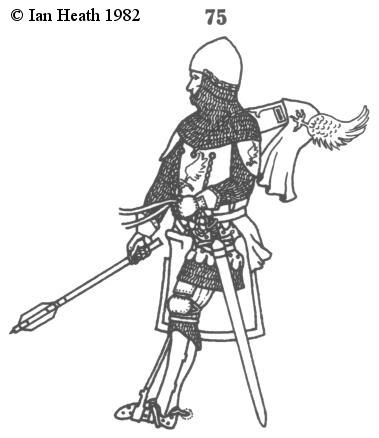
Join Amazon Prime - Watch Thousands of Movies & TV Shows Anytime - Start Free Trial Now
ITALIAN MAN-AT-ARMS c.1341
An extract from Armies of the Middle Ages, volume 1by Ian Heath



75. ITALIAN MAN-AT-ARMS c.1341
Based on the tombstone of Colaccio Beccadelli at Imola, this figure portrays characteristic harness of the period under a cyclas-style surcoat. His body-armour comprises a gambeson and mail hauberk under a coat-of-plates, to the chest of which his sword, dagger and helmet are attached by guard-chains. The surcoat displays his arms (azure, a winged claw or) on both front and back and on the triangular shoulder flaps. His lower-legs are protected by leather greaves, his thighs by gamboised cuisses over which poleyns and rectangular thigh-plates are strapped; the mail fringe hanging below the poleyn probably indicates that a pair of knee-length mail shorts is being worn.
As usual a bascinet with camail is worn under the helm. The helm itself is shown thrown over the shoulder by its chain-guard, a position in which it is frequently depicted in many illustrations of this period, principally Italian. The helm has both crest and lambrequin, Italian pictures continuing to often show crests being worn in battle scenes throughout this era; Uccello's 15th century San Romano paintings, for instance, show somewhat fantastic crests worn by many of the men-at-arms (see figure 77). All in all there is good reason to suppose that crests remained popular in Italy even after they had been relegated to the tournament elsewhere in Europe.
In general terms 14th century Italian armour followed German rather than French styles.